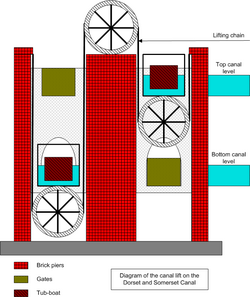James Fussell IV (1748–1832) was an iron magnate operating the Old Iron Works, Mells in Vallis Vale between Mells and Great Elm in Somerset. He was a promoter of the Dorset and Somerset Canal and the inventor of both the roller chain and the balance lock.
Invention of the balance lock
Main article: Balance lock
The balance lock was a type of boat lift designed by James Fussell IV to transport boats up and down a hillside on a canal. An experimental balance lock was built as part of the Dorset and Somerset Canal
Invention of roller chain
Main article: Roller chainSketches by Leonardo da Vinci in the 16th century show a chain with a roller bearing. In 1800, James Fussell IV patented a roller chain on development of his balance lock and in 1880 Hans Renold patented a bush roller chain.
Business history
James Fussell III had leased the site in Mells in 1744, to erect "a good, firme and substantiall Mill or Mills for Grinding Edge Tools and forging Iron plates". His son, James Fussell IV further developed the business. At one time it employed 250 people and continued for many years, with various members of the Fussell family operating a total of six sites in the local area: the Upper Works further up the Wadbury Valley, the Great Elm Edge-Tool Works, the Chantry Works, the Railford Works and a small site at Gurney Slade. Tools produced by Fussells were exported to Europe and America, and the family expanded its activities to include coal mining and banking, with the business issuing its own banknotes at one stage.
The business declined towards the end of the 19th century, due in part to a failure to convert from water to steam power until a late stage, and also to the collapse of English agriculture in the 1870s. By 1895 production had ceased, and the company folded in 1900.
References
- Atthill, Robin (1971). Old Mendip (2nd ed.). Newton Abbot: David & Charles. ISBN 0715351710.
- In the 16th century, Leonardo da Vinci made sketches of what appears to be the first steel chain. These chains were probably designed to transmit pulling, not wrapping, power because they consist only of plates and pins and have metal fittings. However, da Vinci's sketch does show a roller bearing.Tsubakimoto Chain Co., ed. (1997). The Complete Guide to Chain. Kogyo Chosaki Publishing Co., Ltd. p. 240. ISBN 0-9658932-0-0. p. 211. Retrieved 17 May 2006.
- "The Repertory of Patent Inventions, and Other Discoveries and Improvements in Arts, Manufactures, and Agriculture: Being a Continuation, on an Enlarged Plan, of the Repertory of Arts and Manufactures ..." G. and T. Wilkie. 1800. p. 303. Retrieved 7 January 2021.
- Reid, Carlton (2015). Roads were not built for cars : How cyclists were the first to push for good roads & became the pioneers of motoring. Washington, DC: Island Press. p. 196. ISBN 9781610916899.
- Atthill, Robin (1964). Old Mendip. Newton Abbott: David and Charles. ISBN 0715351710.
- ^ Fussell, James (2001). The Fussell ironworks at Wadbury, Mells: An Introduction Archived 2011-07-26 at the Wayback Machine. Retrieved 8 February 2010.
- Industrial archaeology - Fussell's iron works, British Geological Survey. Retrieved 8 February 2010.
- The Fussells Iron Industry Story, Fussells Iron Industry Society. Retrieved 8 February 2010.
- Mark Adler (December 2010). "When Fussells had the edge". Mendip Times. 6 (7): 89.